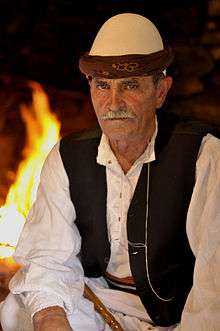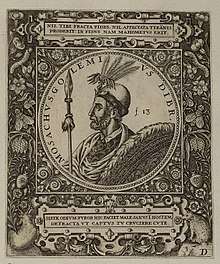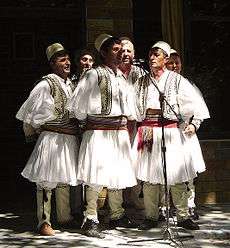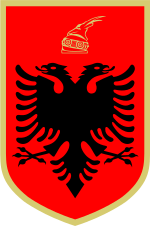Qeleshe
The qeleshe or plis, also qylaf[1] is a white brimless felt cap traditionally worn by Albanians. It has spread throughout Albanian-inhabited territories, and is today part of the traditional costume of the Albanians. The height of the cap varies region to region.[1]

Etymology
_-_Nationalmuseum_-_18601.tif.jpg)
In Albanian: def. sin. qeleshja or plisi, indef. pl. qeleshe or plisa, def. pl. qeleshet or plisat.
The style of cap is thought to originate from a similar cap worn by the Illyrians.[2][3]
The word qeleshe comes from the Albanian word for wool (lesh).[4] According to Vladimir Orel, the word plis comes from Proto-Albanian *p(i)litja, related to Old High German filiz id., Latin pellis id. and Greek πῖλος pilos id., Proto-Slavic *pьlstь id.;[5] according to Michael Driesen, Orel's reconstruction is incorrect.[6]
Overview
The cap is part of the traditional costume of the Albanian highlanders[7][8] and is considered as a national symbol among a large number of Albanian communities.[9] During the Ottoman period, the hat as a white colored fez cap was the characteristic Albanian national headgear, in particular of Muslim Albanians.[1][10]
In the northern Albanian highlands, the shape is hemispherical, while in Kukës, it is truncated.[11] In southern Albania, the cap is taller than in northern Albania, especially in the Gjirokastër and Vlorë regions, with the exception of the Myzeqe low plains region. In some areas of southern Albania the cap has a small protrusion. The cap is made from one single piece of woolen felt, usually white, that is molded to the shape of the head.[11]
The town of Kruja is particularly known for Albania's traditional felt-makers who also produce the felt caps qeleshe.[12] The cap is used by men during the traditional weddings of the Tirana region.[13]
Gallery
 Hemispherical type qeleshe or plis.
Hemispherical type qeleshe or plis. Flat-topped fez type qeleshe.
Flat-topped fez type qeleshe.- Hemispherical, oval and flat topped shapes of qeleshe.
 A felt-maker.
A felt-maker. Moisi Golemi, engraving by Johann Theodor de Bry, 1596.
Moisi Golemi, engraving by Johann Theodor de Bry, 1596. Ferenc Nopcsa in northern Albanian costume, 1913.
Ferenc Nopcsa in northern Albanian costume, 1913. Albanian music trio with hemispherical type qeleshe, Has District.
Albanian music trio with hemispherical type qeleshe, Has District. Albanian singers with flat-topped type qeleshe, Skrapar.
Albanian singers with flat-topped type qeleshe, Skrapar.
See also
| Wikimedia Commons has media related to Qeleshe. |
- Culture of Albania
- List of hats and headgear
- Pileus
- Opinga
- Traditional clothing of Kosovo
References
- Di Monaco, Florindo (1999). Un mondo di acconciature: itinerario alla scoperta di centomila idee e misteri che vengono quotidianamente al pettine. Edizioni scientifiche italiane. p. 354. ISBN 9788881145300.CS1 maint: ref=harv (link) "Gli Albanesi, in parte di religione musulmana, conservano del lunghissimo periodo della dominazione turca il caratteristico fez bianco {qylaf o qeleshe), autentico copricapo nazionale, la cui altezza varia da regione a regione."
- Stipčević, Aleksandar (1977). The Illyrians: History and Culture. History and Culture Series. Noyes Press. p. 89. ISBN 0815550529.
It is generally agreed, and rightly so, that the modern Albanian cap originates directly from the similar cap worn by the Illyrians.
- Recherches albanologiques: Folklore et ethnologie. Instituti Albanologijik i Prishtinës. 1982. p. 52. Retrieved 14 April 2013.
Ne kuadrin e veshjeve me përkime ilire, të dokumentuara gjer më tani hyjnë tirqit, plisi, qeleshja e bardhë gjysmësferike, goxhufi-gëzofi etj
- Vladimir Orel (1998). Albanian Etymological Dictionary. Brill Academic Pub. p. 219. ISBN 9004110240.
- Vladimir Orel (1998). Albanian Etymological Dictionary. Brill Academic Pub. p. 334. ISBN 9004110240.
- C. Driessen, Michael (2004). "Towards an Indo-European Term for 'Felt'". Journal of Indo-European Studies: 32.
Alb. plis recently received an etymology by Orel (1998:334) who reconstructs *p(i)litja- which he connects with Lat. pellis 'hide, fur', PSlav. *pblstb 'felt' and Gr. 'πίλος'. It is not very clear what he means with a reconstruction *p(i)litja-. A pre-form *pilitja- with the element *pil- of alleged *pil-s-o- is obviously incorrect. First of all, an element *pil-(s-) 'felt', as argued earlier on, probably does not exist. Secondly, intervocalic *l develops into Albanian ll (Pedersen 1895:535-536). One would therefore expect *pllis.
- Andromaqi Gjergji (2004). Albanian Costumes Through the Centuries: Origin, Types, Evolution. Acad. of Sciences of Albania, Inst. of Folc Culture. ISBN 978-99943-614-4-1.
- Richard C. Hall (9 October 2014). War in the Balkans: An Encyclopedic History from the Fall of the Ottoman Empire to the Breakup of Yugoslavia. ABC-CLIO. pp. 288–. ISBN 978-1-61069-031-7.
- Gjergji, 2004, p. 166: "To this day many zones of the Dukagjin Plateau in Kosova and various zones inhabited by Albanians in Montenegro and Macedonia have preserved their folk costumes or some expressive element of the costume, such as the white "qeleshe" (brimless felt cap) considered as a symbol of their nationality."
- Stipčević, Aleksandar (1977). The Illyrians: history and culture. Noyes Press. p. 89. ISBN 9780815550525.
From among the various caps that the Illyrians wore, one can distinguish four different types. On the monument from Zenica one can see the more common type of skullcap. Fundamentally it does not differ from the present-day small, white Albanian fez known as a qeleshe.
- Nagel (1990). Albania. Nagel Publishers. p. 62. ISBN 978-2-8263-0827-0. Retrieved 14 April 2013.
The qeleshe, the white felt cap worn by men, was a distinctively Albanian type of headgear both within the country and beyond its frontiers" [...] "Among the mountain people of the north it was hemispherical in form; at Kukés in the form of a truncated cone
- Gillian Gloyer (2012). Bradt Albania. Bradt Travel Guides. p. 49. ISBN 978-1-84162-387-0. Retrieved 14 April 2013.
The best place in Albania to shop for souvenirs is Kruja, where all the shops are close together in the bazaar. There are traditional felt-makers, who produce slippers and the felt caps called qeleshe
- Vaqarri, Sabina (2010). "TRADICIONALITET DHE RISI NE DASMËN TIRANASE". Albanological Research - Folklore and Ethnology Series (40): 313–322.
